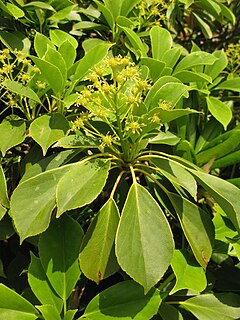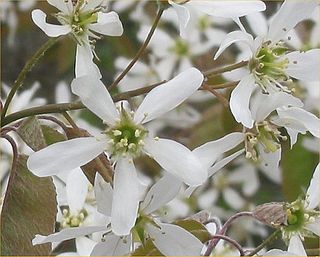
Illicium verum is a medium-sized evergreen tree native to northeast Vietnam and southwest China. A spice commonly called star anise, staranise, star anise seed, star aniseed, Chinese star anise, or badian that closely resembles anise in flavor is obtained from the star-shaped pericarps of the fruit of I. verum which are harvested just before ripening. Star anise oil is a highly fragrant oil used in cooking, perfumery, soaps, toothpastes, mouthwashes, and skin creams. Until 2012, when they switched to using a bacterial source, Roche Pharmaceuticals used up to 90% of the world's annual star anise crop to produce shikimic acid, a chemical intermediate used in the synthesis of oseltamivir (Tamiflu).

Plant reproductive morphology is the study of the physical form and structure of those parts of plants directly or indirectly concerned with sexual reproduction.

Magnolia delavayi is a species of flowering plant in the genus Magnolia. It is known by the common names of Chinese evergreen magnolia or Delavay's magnolia. It was named after Father Delavay, French Catholic missionary in China, who collected it.

Pachypodium brevicaule is a species of plant that belongs to the family Apocynaceae.

Illiciaceae A.C.Sm. was a family of flowering plants recognized in a number of systems of plant taxonomy. The Illiciaceae is not recognized as a distinct family by the APG III system of plant taxonomy, the most well accepted system in use today.

Trochodendraceae is the only family of flowering plants in the order Trochodendrales. It comprises two extant genera, each with a single species along with up to five additional extinct genera and a number of extinct species. The living species are native to south east Asia. The two living species both have secondary xylem without vessel elements, which is quite rare in angiosperms. As the vessel-free wood suggests primitiveness, these two species have attracted much taxonomic attention.

Pleiogynium timoriense, commonly known as the Burdekin plum, sweet plum, tulip plum, or in the Djabugay language guybalum is a medium-sized fruit-bearing tree in the family Anacardiaceae native to Malesia, Australia and the Pacific Islands.

Amelanchier canadensis is a species of Amelanchier native to eastern North America in Canada from Newfoundland west to southern Ontario, and in the United States from Maine south to Alabama. It is largely restricted to wet sites, particularly on the Atlantic coastal plain, growing at altitudes from sea level up to 200 m.

Malus coronaria, also known by the names sweet crabapple or garland crab, is a North American species of Malus (crabapple). It grows primarily in the Great Lakes Region and in the Ohio Valley, with outlying populations as far away as Alabama, eastern Kansas, and Long Island.
Illicium tenuifolium is a species of flowering plant in the family Schisandraceae. It is a tree native to Indo-China and Peninsular Malaysia. It grows in tropical forests, including cloud forests.
Myrcianthes oreophila is a species of tree in the family Myrtaceae. It is native to Peru and also probably Bolivia.
Pittosporum virgatum is a species of plant in the Pittosporaceae family. It is endemic to New Zealand.

Laureliopsis is a genus of flowering plants with just one species, Laureliopsis philippiana, known as tepa and wawán, endemic to Chile and the narrow neighboring strip of Argentina. In Chile it is found from Maule to Aysén. It grows on humid and deep soils.

Leucospermum conocarpodendron, is the largest species of the genus reaching almost tree-like proportions of 5–6 m (16–20 ft) high, with a firm trunk that is covered in a thick layer of cork that protects it from most fires, with greyish or green narrow or broad inverted egg-shaped leaves with three to ten teeth near the tip, and large yellow flowerheads, with firm, bent, yellow styles that stick far beyond the rest of the flower and give the impression of a pincushion. It is commonly known as the tree pincushion in English or goudsboom in Afrikaans. They naturally occur near Cape Town, South Africa. Two subspecies are distinguished. L. conocarpodendron subsp. conocarpodendron, that has greyish leaves because they have a covering of felty hairs. L. conocarpodendron subsp. viridum, has green leaves that lack felty hairs. Flowers can be found between August and December.

Aponogeton lakhonensis is a species of an aquatic genus Aponogeton, itself the only genus in the Aponogetonaceae family. This species with a yellow-flowered single spike rising above the water, is found in ricefields, ponds and slow-moving streams of tropical and sub-tropical Asia. An outlier population occurs in Sulawesi, the main area of occurrence is from Thailand to Zhōngguó/China and Assam in India. It is more closely related to tropical Australian species of Aponogeton than it is to other Southeast Asian species. In Thailand the whole plant is eaten is salads, whereas Cambodians prefer the leaves alone served with fish sauce.

Cinnamomum kanehirae, also known as small-flowered camphor tree, or stout camphor tree, is a tree within the genus Cinnamomum of the family Lauraceae endemic to Taiwan.

Leucospermum innovans is an upright evergreen shrub with many pustules growing on the lower branches, wedge-shaped leaves, and oval, flower heads that are yellow on the outside, but with scarlet stripes on the inside of the perianth claws, with long styles sticking far beyond the perianths, jointly giving the impression of a pincushion. It is called Pondoland pincushion or Transkei pincushion in English. Flowers occur on and off between July and December, but flowering peaks in September and October.

Leucospermum winteri is an evergreen, rounded shrub up to 1⅓ m (5 ft) tall in the family Proteaceae. Its slightly smelling flower heads can be found between July and December, and are pollinated by insects such as flies and bees. About two months after flowering the fruits are ripe and fall to the ground. Here, these are gathered by native ants that carry them to their underground nests, where the seeds remain safe until overhead fire and removal of the biomass trigger gemination. The plants of this species do not survive the fire that occurs naturally in its fynbos habitat. This species is an endemic of the Langkloof between the Gourits River Valley and Garcia's Pass in the Langeberg, where it occurs on the ridges at 1100–1300 m (3600–4250 ft) elevation. Although only a few hundred plants are known, the population is stable, so the species is only regarded near threatened. It is called Riversdale pincushion in English.

Protea pendula, also known as the nodding sugarbush or arid sugarbush, is a flowering plant of the genus Protea, in the family Proteaceae, which is only found growing in the wild in the Cape Region of South Africa. In the Afrikaans language it is known as knikkopsuikerbossie or ondersteboknopprotea.

Protea sulphurea, also known as the sulphur sugarbush, is a flowering plant of the genus Protea in the family Proteaceae, which is only known to grow in the wild in the Western Cape province of South Africa. A vernacular name for the plant in the Afrikaans language is heuningkoeksuikerbos or Skaamblom.

















